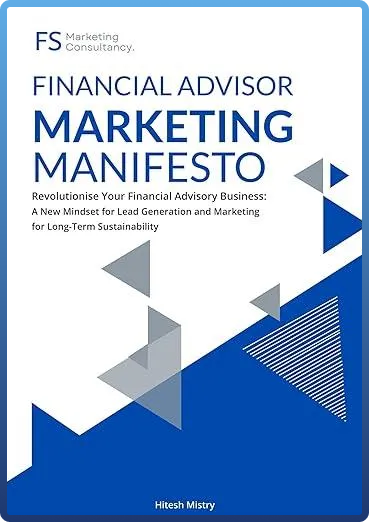We'll Install The Perfect Lead Gen System Into Your Business...
...So that you don’t need to worry where your next qualified lead is going to come from for the rest of your business life!
Speak to us about our single fee setup, no retainer offer!
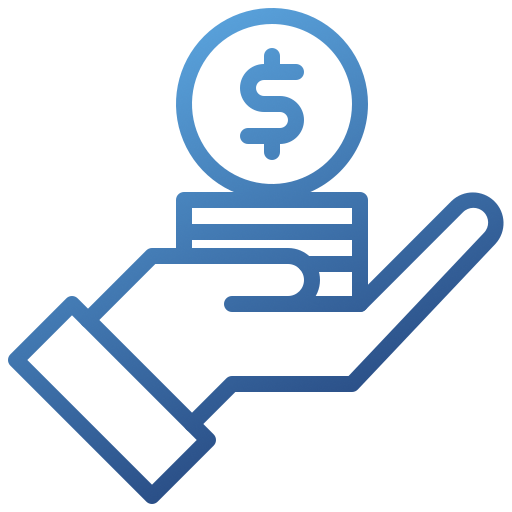
Financial Services
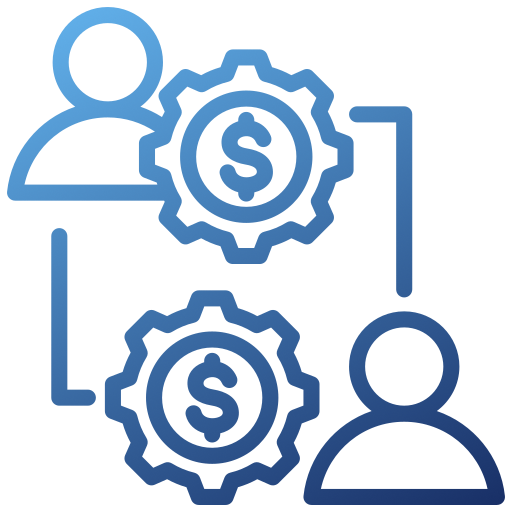
Business to Business (B2B)
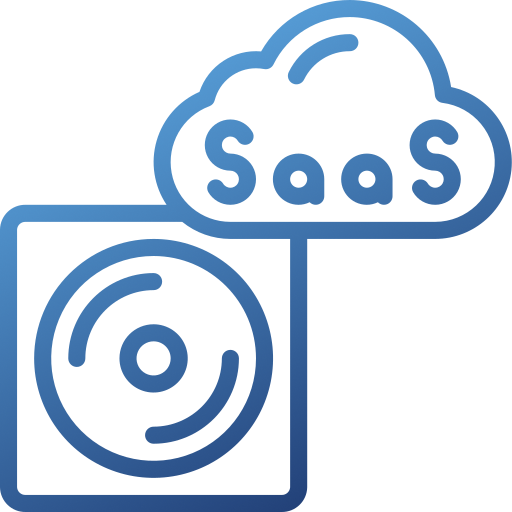
Software as a Service (SaaS)
A Lead Generation System Where Your Ideal Customers Hang Out!
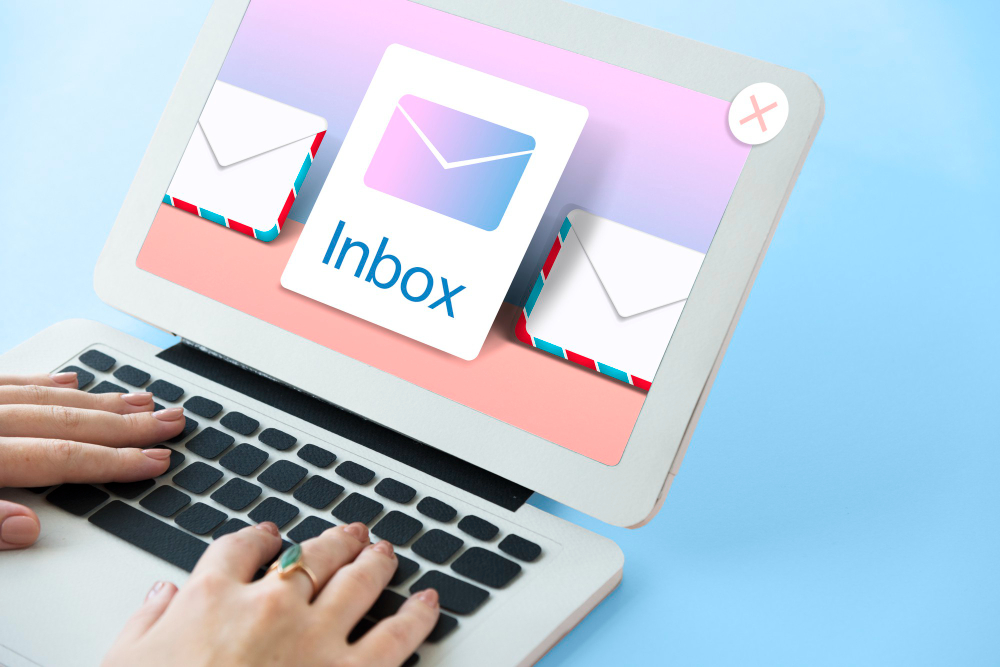
Cold Email
We'll build an automated email outreach system that will get you in front of 10k+ ideal customers every single month.

Facebook Ads
We’ll help you harness the potential of Facebook ads to generate new, highly qualified leads.

LinkedIn Ads & Outreach
We’ll help you leverage the power of LinkedIn ads to generate new, highly qualified leads and create valuable connections.

Meet Hitesh!
We'll build an automated email outreach system that will get you in front of 10k+ ideal customers every single month.
I've been fortunate to work with companies all around the world across Financial Services, B2B and SaaS generating thousands of leads, appointments and demos, helping clients grow their revenue.
Got a question about lead gen?
Book a call below or connect with me directly on LinkedIn.
What They Say About Us
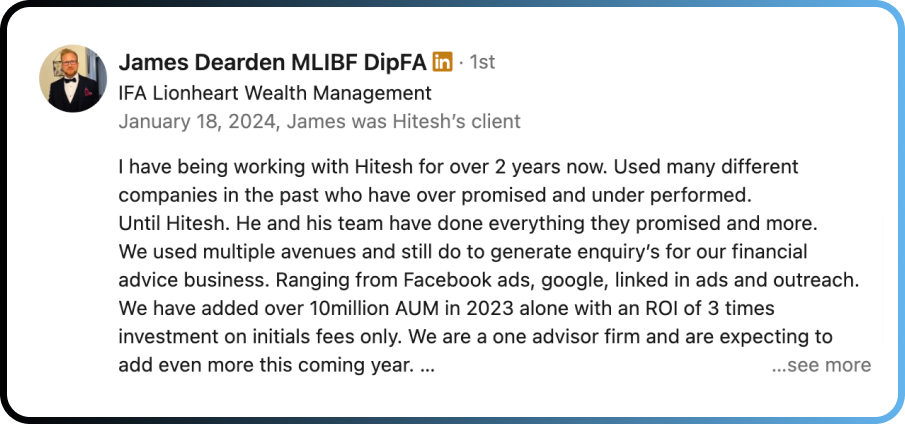
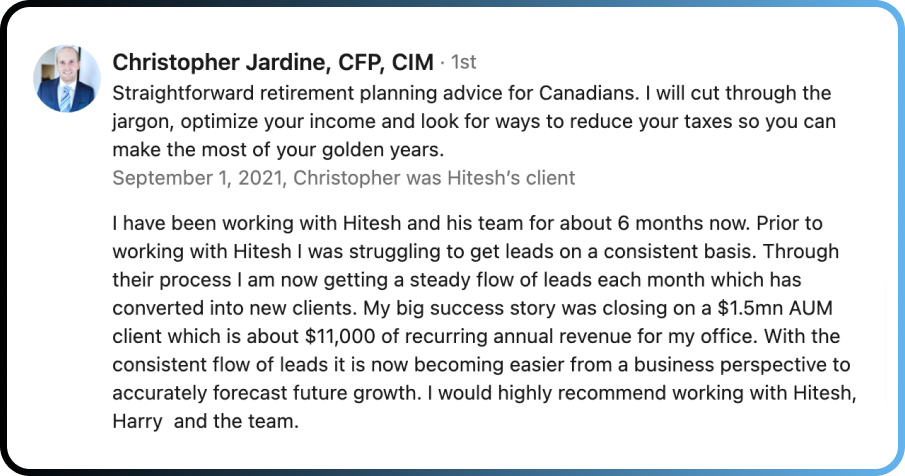
Recent Lead Generation System Results
Some example results from our Cold Email, Facebook, LinkedIn Ads & Outreach campaigns.
Our Latest Lead Gen Insights

What is the next step if no response from cold email outreach sequence?
So, you've put in the time and effort to create a compelling cold email outreach sequence. You've meticulously crafted personalized emails, perfected your subject lines, and hit the send button. But what do you do when you don't receive a response?
In this article, we'll explore the next steps you should take if your cold email outreach sequence isn't yielding the desired response rates. We'll delve into effective follow-up strategies and provide guidance on how to boost your chances of getting a reply.
Key Takeaways:
Understand the importance of A/B testing to optimize your cold email outreach sequence.
Learn strategies to enhance email open rates and improve email deliverability.
Craft attention-grabbing hooks and offers to capture your prospects' interest.
Implement personalization techniques to make your cold emails more compelling and relevant.
Discover smart follow-up strategies to increase engagement and response rates.
By implementing these key takeaways, you'll be equipped with the knowledge and strategies to overcome the challenges of cold email outreach and improve your response rates.
Understanding the Importance of A/B Testing
When it comes to optimizing your cold email outreach sequence, A/B testing is an essential tool in your arsenal. By testing different elements of your emails, such as subject lines and email copy, you can gather valuable insights that can significantly improve your response rates.
A/B testing involves creating two versions of an email with slight variations and sending them to different segments of your audience. By comparing the performance of these two versions, you can determine which elements are more effective in capturing your recipients' attention and driving engagement.
One key area to focus on during A/B testing is the subject line. This is your first opportunity to make a positive impression and entice your prospects to open your email. Try experimenting with different subject line styles, such as personalized vs. generic, or asking a question vs. making a statement. Analyzing the open rates of these variations can provide valuable insights into what resonates best with your audience.
Another crucial element to test is your email copy. Crafting compelling and persuasive content is vital for motivating your recipients to take action. Consider testing different writing styles, tones, or approaches to see which resonate best with your audience. You may discover that a more conversational tone or a clear call-to-action generates higher response rates.
Tip: Keep in mind that A/B testing should focus on one variable at a time. This allows you to isolate the impact of each element and make data-driven decisions.
How to Conduct A/B Tests
Define your goals: Determine what specific aspect of your email campaign you want to optimize, whether it's open rates, click-through rates, or conversions.
Identify the variables: Select the elements you want to test, such as subject lines, email copy, call-to-action buttons, or even different email templates.
Create variations: Develop two or more versions of your email, making small changes to the selected variables. Make sure each version has a unique identifier for tracking purposes.
Segment your audience: Randomly divide your recipient list into groups and assign each group to receive a different version of your email.
Monitor and track results: Use email marketing analytics tools to measure the performance of each variation. Pay attention to open rates, click-through rates, and any other relevant metrics.
Interpret and iterate: Analyze the results to identify the winning version, and apply those learnings to future campaigns. Don't be afraid to continue testing and refining your approach to maximize your cold email outreach success.
By harnessing the power of A/B testing, you can gain valuable insights into what works best for your cold email outreach sequence. It allows you to make data-driven decisions, improve your email engagement, and ultimately increase your response rates.
Enhancing Email Open Rates and Delivery Rates
When it comes to your cold email outreach sequence, increasing email open rates and ensuring successful email delivery are crucial factors in achieving a higher response rate. In this section, we will explore effective strategies to enhance email open rates and optimize email deliverability.
1. Craft Compelling Subject Lines
Your email subject line is the first thing that recipients see in their inbox, so it's essential to make it attention-grabbing and compelling. Use keywords and phrases that resonate with your target audience and pique their curiosity. Experiment with different subject lines through A/B testing to identify the ones that generate the highest open rates.
2. Optimize Email Deliverability
Email deliverability refers to the successful delivery of your emails to the recipients' inboxes, avoiding spam filters or junk folders. Avoid using spam trigger words and phrases and ensure that your email infrastructure and sending practices comply with best practices and industry standards. Regularly monitor and maintain a clean email list to minimize bounces and keep your sender reputation intact.
3. Segment Your Email List
Segmenting your email list allows you to tailor your message and content to specific groups of recipients, increasing the relevance and personalization of your emails. By understanding your audience's interests and needs, you can optimize your email copy and offers, leading to higher open rates and engagement.
4. Use Personalization Techniques
Personalization creates a connection with your recipients and makes your emails feel more personalized and relevant. Address recipients by their names, reference past interactions or specifics about their business, and provide customized content whenever possible. Utilize data from your CRM or email marketing software to personalize your cold email outreach effectively.
5. Implement Multi-Touchpoint Outreach
Instead of relying on a single email, consider implementing a multi-touchpoint outreach strategy. This approach involves sending a series of well-crafted follow-up emails to prospects who haven't responded to your initial message. Timing is key, so schedule these follow-ups strategically to avoid appearing too persistent or annoying.
By incorporating these strategies into your cold email outreach sequence, you can enhance your email open rates and ensure that your messages reach your intended recipients' inboxes. Remember to continuously test and refine your approaches to optimize your overall response rates.
Crafting an Attention-Grabbing Hook and Offer
When it comes to cold email outreach, the success of your campaign hinges on your ability to capture the interest of your prospects. This starts with crafting an attention-grabbing hook and offer that resonates with your target audience.
A powerful hook is like a strong first impression—it piques curiosity, generates intrigue, and compels recipients to keep reading. Your hook should address a pain point, highlight a benefit, or pose a thought-provoking question that sparks their interest.
Once you've hooked their attention, it's time to present an irresistible offer. Your offer should provide clear value and demonstrate how you can solve their problem or fulfill their needs. Whether it's a free trial, a special discount, or exclusive content, make sure your offer is tailored to your prospects' interests and motivates them to take action.
Here are some tips to help you craft an attention-grabbing hook and offer:
Know your audience: Research your prospects thoroughly to understand their pain points, goals, and interests. Tailor your hook and offer to address their specific needs.
Be clear and concise: Keep your hook and offer concise and to the point. Avoid overwhelming prospects with too much information.
Create a sense of urgency: Incorporate a time-limited element to your offer to create a sense of urgency and encourage immediate action.
Provide social proof: Share testimonials, case studies, or success stories to build credibility and reassure prospects that your offer is valuable.
Personalize your hook and offer: Use personalization tactics, such as addressing recipients by name or referencing their industry, to make your hook and offer more relevant and compelling.
Remember, your hook and offer are the keys to capturing your prospects' attention and motivating them to respond to your cold emails. By incorporating these strategies into your outreach campaign, you'll increase your chances of generating positive responses and driving meaningful conversations with your prospects.
Personalization Techniques for Cold Email Outreach
When it comes to cold email outreach, personalization is the secret ingredient that can make a significant difference in your response rates. By tailoring your emails to each recipient, you demonstrate that you've taken the time to understand their needs and challenges. Here are a few personalization techniques that can help you stand out in the inbox:
1. Addressing Recipients by Name
Using someone's name is a simple yet effective way to grab their attention and make your email feel more personalized. Instead of using generic greetings like "Hi there" or "Dear Sir/Madam," take the time to find out the recipient's name and address them directly. This small gesture can go a long way in establishing a connection and increasing the likelihood of a response.
2. Referencing Specific Details
Generic emails that lack relevance to the recipient's business are more likely to be ignored. To avoid this, do your research and include specific details about their company, recent achievements, or industry trends. This demonstrates that you've taken an interest in their organization and are offering something that is specifically relevant to them.
3. Highlighting Mutual Connections or Interests
If you share any common connections or interests with the recipient, be sure to mention them in your email. Mutual connections can help establish credibility and trust, while common interests create an immediate bond. This personalized touch can make your email stand out and pique the recipient's interest.
4. Customizing Email Content
In addition to personalizing the opening of your email, customize the content to address the recipient's specific pain points or challenges. Show that you understand their needs and present a solution that is tailored to them. This level of personalization shows that you've done your homework and increases the chances of a positive response.
By implementing these personalization techniques, you can create cold emails that feel more genuine, relevant, and engaging. Remember, personalization is all about making a connection with your recipients and showing them that you value their time and interests.
Implementing Smart Follow-Up Strategies
Follow-up emails are a vital component of your cold email outreach sequence. They play a crucial role in maintaining engagement with your prospects and nudging them towards taking action. In this section, we'll share effective follow-up strategies that can help you revive cold leads and increase your overall response rates.
1. Be Persistent, But Not Pushy
When crafting your follow-up emails, it's important to strike the right balance between persistence and being overly pushy. Avoid bombarding your prospects with multiple emails in a short span of time, as this can come across as aggressive or spammy. Instead, space out your follow-ups strategically to stay on their radar without overwhelming them.
2. Provide Additional Value
One effective way to engage with your prospects through follow-up emails is by providing them with additional value. Offer them relevant industry insights, helpful resources, or exclusive content that aligns with their interests and pain points. This demonstrates your expertise and shows that you genuinely care about helping them succeed.
3. Personalize Your Follow-Ups
Personalization is key when it comes to follow-up emails. Referencing previous conversations or specific details about your prospects' businesses shows that you've done your research and are genuinely interested in working with them. Make sure to address your prospects by their names and tailor your follow-up messages based on their unique needs and challenges.
4. Create a Sense of Urgency
Adding a sense of urgency to your follow-up emails can increase your prospects' motivation to take action. Highlight time-limited offers, upcoming deadlines, or exclusive opportunities that they don't want to miss out on. By creating a sense of urgency, you encourage prompt responses and increase the chances of conversion.
5. Experiment with Different Approaches
Don't be afraid to experiment with different follow-up strategies to find what works best for your audience. Test different subject lines, email templates, and call-to-actions to see which ones generate the highest response rates. Analyze the results and optimize your follow-up approach based on the insights gained.
By implementing these smart follow-up strategies, you can boost the effectiveness of your cold email outreach sequence and increase your chances of converting leads into valuable customers. Now that you have the right tools in your arsenal, it's time to put them into action and experience the power of strategic follow-ups.
Conclusion
In conclusion, maximizing the success of your cold email outreach sequence requires a combination of strategic follow-up, personalization, and continuous optimization. By implementing the strategies discussed in this article, such as conducting A/B tests and enhancing your email open rates, you can improve your response rates and increase your chances of converting prospects into customers.
Remember that crafting an attention-grabbing hook and offer is crucial in capturing your recipients' interest and motivating them to respond. Additionally, personalization techniques, such as addressing prospects by name and referencing specific details about their business, can make your emails feel more personalized and relevant.
Lastly, implementing smart follow-up strategies is essential for keeping the conversation going and nurturing cold leads. By staying persistent but respectful, you can revive potential opportunities and ultimately achieve your desired outcomes.








